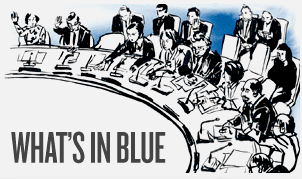DPRK Resolution Adoption
The Security Council seems set to adopt a resolution today (22 January) at 3pm responding to the missile launch of the Democratic People’s Republic of Korea (DPRK) on 12 December 2012. In remarks to the press on behalf of Council members following the event, the Council President in December, Ambassador Mohammed Loulichki (Morocco), said that the launch was a “clear violation” of Council resolutions 1718 (2006) and 1874 (2009). Since that time, the Council has been in discussions over an appropriate response, with negotiations primarily—if not exclusively—taking place between China and the US up until this week.
It seems that agreement was reached between Washington and Beijing on a draft text at the end of last week. There had been considerable discussion for some weeks between the two permanent members on the format of the Council’s response to the DPRK’s prohibited launch. (Following its 13 April 2012 satellite launch, the Council adopted a presidential statement [S/PRST/2012/13] which expressed “its determination to take action accordingly in the event of a further DPRK launch or nuclear test.”)
It seems that the US deemed it appropriate to take a stronger stand against Pyongyang, given the warning the Council had provided about further prohibited activity, and was in favour of adopting a resolution with further sanctions against the DPRK. (The Council has previously adopted two rounds of sanctions: the first following the DPRK’s 2006 nuclear test, and the second after its 2009 nuclear test.)
Apparently China had preferred a proportional response to its neighbour’s latest launch and was possibly in favour of the Council adopting another presidential statement condemning the DPRK’s violation of Council resolutions. A spokesperson for China’s foreign ministry stated that Beijing was working constructively on a Council response and, like other members, regretted that the DPRK went ahead with the launch “amid widespread concerns by the international community.” China also noted however that a Council response should be “prudent, moderate, and conducive to peace and stability in the Korean Peninsula, and should prevent the situation from escalating further.”
The text ultimately agreed upon between China and the US is in the form of a draft resolution. However, rather than setting out a new (third) round of sanctions against the DPRK, it added individuals and entities (companies) to the existing sanctions regime. The draft resolution was shared among all 15 Council members for the first time yesterday (21 January) as the drafters were keen to adopt early in the week.
In terms of the substance of the draft resolution, it seems that some delegations had questions when experts met on Monday afternoon. However, given that agreement had been reached between China and the US after prolonged bilateral negotiations, it seems that there was little room for re-opening the content of the text and the resolution was put in blue.
In condemning the DPRK’s launch, the draft text calls on Pyongyang to abandon all nuclear weapons and existing nuclear programmes in a “complete, verifiable and irreversible manner” and in that sense reiterates its obligations under resolutions 1718 and 1874. The draft resolution apparently also contains two annexes: one containing the names of four DPRK individuals to be subject to the existing travel ban and asset freeze; and a second designating six entities—five in the DPRK and one in Hong Kong—to be subject to an asset freeze. This list includes the “Korean Committee for Space Technology,” which—according to the draft—“orchestrated the DPRK’s launches on 13 April 2012 and 12 December 2012.”
Among elected members, as with other P5 members, there seems to be a clear consensus that the DPRK demonstrably violated Council resolutions and that such an appropriate response was necessary from the Council. From a working methods perspective, some elected members seem less than amused that they had such little time to weigh-in on the draft resolution before the expected adoption.
Follow us on Twitter

